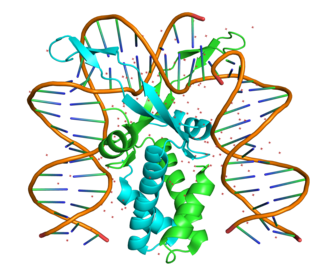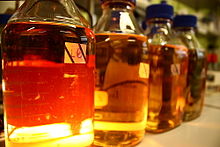
Enterobacteria phage λ is a bacterial virus, or bacteriophage, that infects the bacterial species Escherichia coli. It was discovered by Esther Lederberg in 1950. The wild type of this virus has a temperate life cycle that allows it to either reside within the genome of its host through lysogeny or enter into a lytic phase, during which it kills and lyses the cell to produce offspring. Lambda strains, mutated at specific sites, are unable to lysogenize cells; instead, they grow and enter the lytic cycle after superinfecting an already lysogenized cell.

Max Ludwig Henning Delbrück was a German–American biophysicist who participated in launching the molecular biology research program in the late 1930s. He stimulated physical scientists' interest into biology, especially as to basic research to physically explain genes, mysterious at the time. Formed in 1945 and led by Delbrück along with Salvador Luria and Alfred Hershey, the Phage Group made substantial headway unraveling important aspects of genetics. The three shared the 1969 Nobel Prize in Physiology or Medicine "for their discoveries concerning the replication mechanism and the genetic structure of viruses". He was the first physicist to predict what is now called Delbrück scattering.

Salvador Edward Luria was an Italian microbiologist, later a naturalized U.S. citizen. He won the Nobel Prize in Physiology or Medicine in 1969, with Max Delbrück and Alfred Hershey, for their discoveries on the replication mechanism and the genetic structure of viruses. Salvador Luria also showed that bacterial resistance to viruses (phages) is genetically inherited.

Escherichia virus T4 is a species of bacteriophages that infect Escherichia coli bacteria. It is a double-stranded DNA virus in the subfamily Tevenvirinae from the family Myoviridae. T4 is capable of undergoing only a lytic life cycle and not the lysogenic life cycle. The species was formerly named T-even bacteriophage, a name which also encompasses, among other strains, Enterobacteria phage T2, Enterobacteria phage T4 and Enterobacteria phage T6.
In biology, a strain is a genetic variant, a subtype or a culture within a biological species. Strains are often seen as inherently artificial concepts, characterized by a specific intent for genetic isolation. This is most easily observed in microbiology where strains are derived from a single cell colony and are typically quarantined by the physical constraints of a Petri dish. Strains are also commonly referred to within virology, botany, and with rodents used in experimental studies.

The Luria–Delbrück experiment (1943) demonstrated that in bacteria, genetic mutations arise in the absence of selective pressure rather than being a response to it. Thus, it concluded Darwin's theory of natural selection acting on random mutations applies to bacteria as well as to more complex organisms. Max Delbrück and Salvador Luria won the 1969 Nobel Prize in Physiology or Medicine in part for this work.
Milislav Demerec was a Croatian-American geneticist, and the director of the Department of Genetics, Carnegie Institution of Washington [CIW], now Cold Spring Harbor Laboratory (CSHL) from 1941 to 1960, recruiting Barbara McClintock and Alfred Hershey.

Lysogeny broth (LB) is a nutritionally rich medium primarily used for the growth of bacteria. Its creator, Giuseppe Bertani, intended LB to stand for lysogeny broth, but LB has also come to colloquially mean Luria broth, Lennox broth, life broth or Luria–Bertani medium. The formula of the LB medium was published in 1951 in the first paper of Bertani on lysogeny. In this article he described the modified single-burst experiment and the isolation of the phages P1, P2, and P3. He had developed the LB medium to optimize Shigella growth and plaque formation.
P elements are transposable elements that were discovered in Drosophila as the causative agents of genetic traits called hybrid dysgenesis. The transposon is responsible for the P trait of the P element and it is found only in wild flies. They are also found in many other eukaryotes.
Allan McCulloch Campbell was an American microbiologist and geneticist and the Barbara Kimball Browning Professor Emeritus in the Department of Biology at Stanford University. His pioneering work on Lambda phage helped to advance molecular biology in the late 20th century. An important collaborator and member of his laboratory at Stanford University was biochemist Alice del Campillo Campbell, his wife.
A suppressor mutation is a second mutation that alleviates or reverts the phenotypic effects of an already existing mutation in a process defined synthetic rescue. Genetic suppression therefore restores the phenotype seen prior to the original background mutation. Suppressor mutations are useful for identifying new genetic sites which affect a biological process of interest. They also provide evidence between functionally interacting molecules and intersecting biological pathways.

Esther Miriam Zimmer Lederberg was an American microbiologist and a pioneer of bacterial genetics. She discovered the bacterial virus lambda phage and the bacterial fertility factor F, devised the first implementation of replica plating, and furthered the understanding of the transfer of genes between bacteria by specialized transduction.

The history of model organisms began with the idea that certain organisms can be studied and used to gain knowledge of other organisms or as a control (ideal) for other organisms of the same species. Model organisms offer standards that serve as the authorized basis for comparison of other organisms. Model organisms are made standard by limiting genetic variance, creating, hopefully, this broad applicability to other organisms.

The mobilome is the entire set of mobile genetic elements in a genome. Mobilomes are found in eukaryotes, prokaryotes, and viruses. The compositions of mobilomes differ among lineages of life, with transposable elements being the major mobile elements in eukaryotes, and plasmids and prophages being the major types in prokaryotes. Virophages contribute to the viral mobilome.
The phage group was an informal network of biologists centered on Max Delbrück that contributed heavily to bacterial genetics and the origins of molecular biology in the mid-20th century. The phage group takes its name from bacteriophages, the bacteria-infecting viruses that the group used as experimental model organisms. In addition to Delbrück, important scientists associated with the phage group include: Salvador Luria, Alfred Hershey, Seymour Benzer, Charles Steinberg, Gunther Stent, James D. Watson, Frank Stahl, and Renato Dulbecco.
A P1-derived artificial chromosome, or PAC, is a DNA construct derived from the DNA of P1 bacteriophages and Bacterial artificial chromosome. It can carry large amounts of other sequences for a variety of bioengineering purposes in bacteria. It is one type of the efficient cloning vector used to clone DNA fragments in Escherichia coli cells.

Bacteriophage P2, scientific name Escherichia virus P2, is a temperate phage that infects E. coli. It is a tailed virus with a contractile sheath and is thus classified in the genus Peduovirus, subfamily Peduovirinae, family Myoviridae within order Caudovirales. This genus of viruses includes many P2-like phages as well as the satellite phage P4.

Escherichia coli is a Gram-negative gammaproteobacterium commonly found in the lower intestine of warm-blooded organisms (endotherms). The descendants of two isolates, K-12 and B strain, are used routinely in molecular biology as both a tool and a model organism.
Jean-Jacques Weigle was a Swiss molecular biologist at Caltech and formerly a physicist at the University of Geneva from 1931 to 1948. He is known for his major contributions on field of bacteriophage λ research, focused on the interactions between those viruses and their E. coli hosts.

The integration host factor (IHF) is a bacterial DNA binding protein complex that facilitates genetic recombination, replication, and transcription by binding to specific DNA sequences and bending the DNA. It also facilitates the integration of foreign DNA into the host genome. It is a heterodimeric complex composed of two homologous subunits IHFalpha and IHFbeta.












